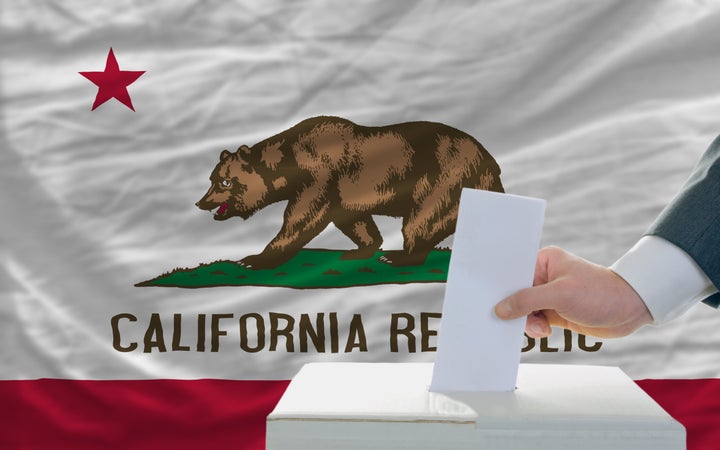
Sen. Dianne Feinstein (D-Calif.) is more or less assured a place in California’s general election after the state votes Tuesday. The race to challenge her, however, remains relatively up for grabs. Most polls of the state’s crowded open primary find progressive Kevin de León the most likely competitor, but a sizable chunk of the electorate, especially on the GOP side, remains undecided.
Earlier this spring, one survey suggested that the person going up against her could be an obscure neo-Nazi named Patrick Little. The online poll from the firm SurveyUSA had Little taking second place behind Feinstein with 18 percent of the vote. The finding, which wasn’t reflected in other surveys, still made a flurry of headlines, prompting swift denunciations from the GOP and a round of anti-Semitic robocalls directed at the senator by a white supremacist group.
The end result: an inconsequential, hate-spewing candidate got a round of unexpected publicity that may have, if anything, boosted his name recognition in a race with no real Republican frontrunners.
But Little’s supposed rise was a quirk of the poll’s design, not an actual groundswell of support. Over the course of the year, SurveyUSA had gradually pared down the “weakest, non-performing candidates” from previous polls. In January, they polled 20 candidates and found Little at just 5 percent, tied for third place with two other little-known Republicans. In March, out of a field of 17, he was again tied for third at 5 percent. In April, with just six names listed ― and with Little and perennial candidate Rocky De La Fuente the only two Republicans ― he jumped to 18 percent.
In their final poll, the survey house reverted to a question that more closely mirrors the California ballot, listing all 32 candidates along with their titles and party IDs, a change that they said in a statement “reflect SurveyUSA’s best current methodological thinking.” Little’s support plunged to 0.
Figuring out which candidates to include is a tricky question for pollsters in nearly every election, but it’s an especially colorful problem in California, where a faithful recreation of the ballot means including longshot candidates with occupations like “puppeteer/musician,” “entrepreneur/transhumanist lecturer” and “blockchain startup CEO,” alongside those with jobs like “lieutenant governor” and “United States Senator.”
Trying to reflect the ballot as closely as possible might seem like the obvious solution. But research has found, for instance, that listing third-party candidates on a survey tends to over-exaggerate their share of the vote, while omitting them understates it. And that’s to say nothing of the challenges faced by pollsters using telephone surveys, who understandably tend to shy away from the idea of having their interviewers read dozens of names and titles over the phone.
Here’s how some of the other pollsters working in California handled the issue:
-The Public Policy Institute of California, which conducts polling by phone, narrowed down the list to “serious” candidates, a process the pollsters have honed going back to the state’s 2003 gubernatorial recall. The criteria, said Mark Baldassare, PPIC’s president and CEO, required candidates to have some financial resources ― at least $100,000 by May ― along with a campaign website, credible endorsements and “some level of media coverage.” That meant a field of six for California’s gubernatorial race, and of just two, Feinstein and De Leon, on the Senate side. Very few survey respondents this year, Baldassare said, have volunteered that they’ll be voting for someone else. PPIC’s May poll found Feinstein leading De Leon, 41 percent to 17 percent, with 36 percent undecided.
-The USC Dornsife/Los Angeles Times poll, which is conducted using an online panel, tried to make their survey mimic the ballot as closely as possible. “We were happy to be able to do this because, generally speaking, polling gets a lot of criticism from minor candidates,” said Jill Darling, the survey’s director. “They always say, ‘Well, if you were polling us, you’d see that we have support.’ So we were happy to be able to let anyone who had a preference for anybody on the ballot participate.” Their final survey gave Feinstein 31 percent and De Leon 7 percent, with the remaining candidates polling below 4 percent and 41 percent of voters still undecided.
-The Berkeley IGS poll, which is also conducted online, included the full list of candidates as well. “We had a sense that there’d be lots of candidates running,” poll director Mark DiCamillo said. “We wanted a method that would enable us to get a sense of how voters would choose in that environment.” Limiting the candidate list, he argued, would also have worked perfectly well in races ranging from the 2003 recall up through this year’s gubernatorial race, but the lack of a strong GOP contender made it a trickier proposition on the Senate side. “The Republicans didn’t know what to do ― it’s very artificial.” The final Berkeley poll put Feinstein at 36 percent, with de Leon at 11 percent and Republican James Bradley at 7 percent. A quarter of voters were undecided.
The good news for California pollsters: come the general election, there’ll only be two candidates to worry about. But the top-two format offers other quirks. If Republicans get locked out of the top-of-the-ticket contests, a feat that doesn’t seem impossible, many Republicans may simply decide not to weigh in.
In 2016, when two Democrats faced off for Senate, Baldassare said, nearly two million people voted for president but not in the senatorial race. “So that’s the interesting twist,” he said, “in the one-party races: how do you evaluate those ‘don’t-know’s’ or ‘I-won’t-vote’s.’”
